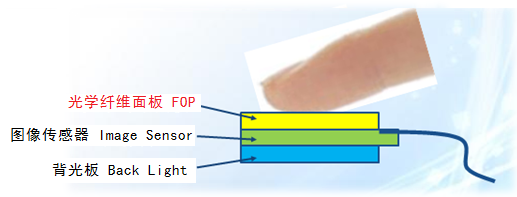Fingerprint and Palm print Scanner base on Fiber Optic Plate
The image intensifier is a vacuum-tube based device (photomultiplier tube) that can generate an image from a very small number of photons (such as the light from stars in the sky) so that a dimly lit scene can be viewed in real-time by the naked eye via visual output, or stored as data for later analysis. While many believe the light is "amplified," it is not. When light strikes a charged photocathode plate, electrons are emitted through a vacuum tube that strike the microchannel plate that cause the image screen to illuminate with a picture in the same pattern as the light that strikes the photocathode, and is on a frequency that the human eye can see. This is much like a CRT television, but instead of color guns the photocathode does the emitting.
The image is said to become "intensified" because the output visible light is brighter than the incoming light, and this effect directly relates to the difference in passive and active night vision goggles. Currently, the most popular image intensifier is the drop-in ANVIS module, though many other models and sizes are available at the market. Recently, the US Navy announced intentions to procure a dual-color variant of the ANVIS for use in the cockpit of airborne platforms.
An image intensifier or image intensifier tube is a vacuum tube device for increasing the intensity of available light in an optical system to allow use under low-light conditions, such as at night, to facilitate visual imaging of low-light processes, such as fluorescence of materials in x-rays or gamma rays (x-ray image intensifier), or for conversion of non-visible light sources, such as near-infrared or short wave infrared to visible. They operate by converting photons of light into electrons, amplifying the electrons (usually with a microchannel plate), and then converting the amplified electrons back into photons for viewing. They are used in devices such as night vision goggles.
Image intensifiers convert low levels of light photons into electrons, amplify those electrons, and then convert the electrons back into photons of light. Photons from a low-light source enter an objective lens which focuses an image into a photocathode. The photocathode releases electrons via the photoelectric effect as the incoming photons hit it. The electrons are accelerated through a high-voltage potential into a microchannel plate (MCP). Each high-energy electron that strikes the MCP causes the release of many electrons from the MCP in a process called secondary cascaded emission. The MCP is tilted to encourage more electron collisions, thus increasing the amount of emission of secondary electrons.
The electrons all move in a straight line due to the high-voltage difference across the plates, which preserves collimation, and where one or two electrons entered, thousands may emerge. A separate (lower) charge differential accelerates the secondary electrons from the MCP until they hit a phosphor screen at the other end of the intensifier, which releases a photon for every electron. The image on the phosphor screen is focused by an eyepiece lens. The amplification occurs at the microchannel plate stage via its secondary cascaded emission. The phosphor is usually green because the human eye is more sensitive to green than other colors and because historically the original material used to produce phosphor screens produced green light (hence the soldiers' nickname 'green TV' for image intensification devices).

